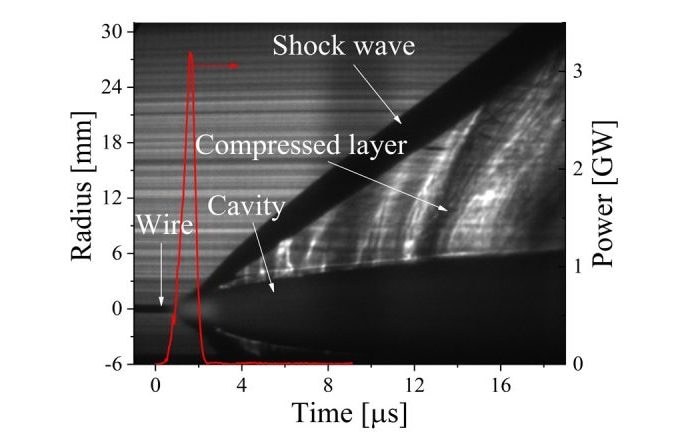May 3 2019
For a normal person, who is not a plasma physicist, exploding electrical wires underwater might seem to be a bad idea. However, as a matter of fact, it is a technique to analyze shock waves, the disturbances that propagate faster than the speed of sound.
 Shadow streak image of the wire explosions overlapped with the deposited power. (Image credit: Rososhek et al.)
Shadow streak image of the wire explosions overlapped with the deposited power. (Image credit: Rososhek et al.)
Analyses of shock waves enable scientists to realize the warm dense matter that exists only under the extreme conditions around stars and produced in the lab for inertial confinement fusion research. Shock waves also find applications in industries and the fields of medicine and defense. One way to produce a shock wave and offer researchers with a tool to verify the equations applied to predict shock waves is to explode an electrical wire underwater.
In a recent paper published in the Physics of Plasmas journal, from AIP Publishing, scientists from the Technion Israel Institute of Technology intended to perceive the relation, if any, between the expansion of the exploding wire and the evolution of a shock wave. They took shadow streak images to observe the shock waves’ trajectory and discovered that the expansion of the wire governs the decay of a shock wave. In addition, they created a simplified model to explain this relationship.
It was observed that a long time after the shock wave is produced, the wire continued to expand, resulting in a considerably slower shock wave compared what was predicted by earlier models. Moreover, in contrast to earlier models, the new model does not assume instantaneous energy release and self-similar motion.
“Surprisingly, and this is the exciting part, the results of this simplified model fit excellently the experimentally obtained results,” stated Alexander Rososhek, one of the authors of the paper. The experiment demonstrated the fact that the exploding wire generating the shock wave expands at subsonic velocity.
This finding, together with one-dimensional hydrodynamic simulations, allowed us to understand in depth the transient process governing shock wave generation and advances our knowledge of shock wave generation as a whole.
Alexander Rososhek, Study Author, Technion Israel Institute of Technology.
To be more precise, these outcomes are applicable to various experimental settings to analyze shock waves. For instance, the outcomes of this study can be applied in experiments in which shock intensity is amplified by water flow, thereby obtaining additional energy by combustion of the exploded wires.
In future studies, Rososhek and the other authors of the study will make efforts to increase the intensity of the shock wave by modifying the properties of the exploding wire, which could offer a supplementary energy deposition. They would also intend to use a high-intensity picosecond-timescale X-ray beam to analyze the initial phase of shock generation as part of collaborative work headed by Simon Bland’s team from the Imperial College of London with the European Synchrotron Radiation Facility.